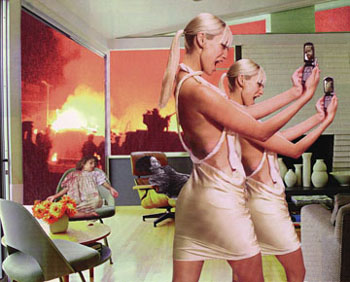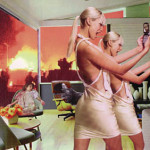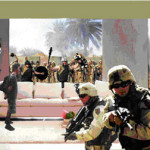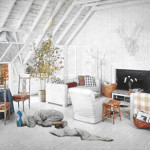By MARTINA TANGA
As your eye moves across the images, a tune is formulated in your head. As it hovers over comfortable household furniture and interiors, you can hear a pleasant melody. Then your eye sees something unexpected, out of place and terribly horrific: a war victim or a bomb explosion. Now you can hear shocking screams - a Hitchcock nightmare. The jarring juxtaposition of the norm and the abnormal, the everyday, for us westerners, and the war – not the quotidian – is what makes these images so powerful.
Martha Rosler created a first series, Bringing the War Home, in 1967 using pictures from the Vietnam War and revisited the theme in her new series Bringing the War Home: New Series with Iraq war imagery in 2004. Both are a brilliant, multi-faceted, complex critique on American’s involvement with the war in Vietnam and Iraq. This is the first time these two series have been brought together in a Museum setting.
These images are photomontages, a medium re-explored in the 60s and 70s. They superimpose views of comfortable post World War II middle class American interiors, epitomized and reproduced in the popular magazine House Beautiful, with unnerving images of war; from soldiers in combat, Vietnam War victims, burning villages and views of bomb shattered landscapes.
Each and every one of these images has a strong political thrust. As a body, the purpose of these images is to make a political statement through agitation imagery. That is not to say we are not dealing with aesthetic questions, but that isn’t the gist. So, how sufficient is this medium for the intention of these images? Is this system of representation adequate and effective?
Photographic medium intrinsically contains the limitations of the medium and points to the rupture between actual social existence and the representation of that social existence. [1] This disjuncture is heightened by the photomontage that creates further rupture within the image. The piecing together of various representations of reality using the photomontage results in still further fragmentation of that social existence.
With this body of work, Rosler examines the importance of finding the right medium for social agency. Of course there is considerable baggage attached to photomontage as a strategy. It has roots in the German Dada in the wake of the First World War in the work of Raul Hausmann, Hanna Höch, and John Heartfield in particular. But Rosler, though acknowledging the importance of these artists, states she was more influenced by indigenous local traditions: in New York the FSA, Lewis Hine and the Film and Photo league. To Rosler, their work seemed to share some of that Popular Front sentimentalism. [2]
In its endeavor to be political and agitational, Rosler’s use of the photomontage points towards an invention of the new and a break from its traditions. Are they successful? Rosler states that she turned to photomontage in the 60s because, in the most obvious way, a ‘photographic montage disrupts the notion of the real while still employing photographic material, which speaks to people with a great degree of immediacy’. [3] What Rosler achieves through photomontage strategy, and the fragmentation intrinsic to photomontage, is a representation of reality that is poignant, shocking and blunt.
For example, in Red Stripe Kitchen from her 67 series, the seamlessness of the picture is so vivid that, at first glance, normality would prevail. Then the shock: two inauspicious soldiers roam around the kitchen looking for something. The clinical cleanliness of the kitchen dramatizes the redness of the bowls, plates, sink and the tomatoes reminiscent of blood and horror. The stool in front, whose perspective seems to have been distorted, literally puts you ‘on edge’.
Rosler deliberately chose publications such as Life Magazines because the editorial layout itself is a strange montage of images. This gives new meaning to her photomontage and a new and powerful element of critique. In these periodicals a cover story may be surrounded by advertisements of products that were supposed to make our life more comfortable and ultimately better. As you turn the page you go from household appliances, the ideal mattress, the designer sofa or the perfect lawn, to cover stories of far away horrors and back to an advertisement for the latest washing softening product.
It is interesting that, driven to re-visit this theme in 2004 by her urgency in response to the US war in Iraq and its subsequent occupation, Rosler chose to execute the images using the same photomontage technique, despite new technologies available, namely, Photoshop. That would have been too easy and seamless. Rosler wanted to retain the ruggedness of the scissors and past technique of photomontage to preserve the social agency present in the strategy and therefore in the earlier series.
There are however differences between the two bodies of work. They shift from the home and domesticity, and challenging that as a political milieu to a less delineated setting: one that is primarily defined by its glamour. To a certain extent, in the later series, Rosler is no longer identifying with the middle classes directly, but challenging their aspirations through today’s popular culture.
An obvious example of this is the insertion of models, catwalk run-ways as well as the in vogue technology, such as cell phones inCellular. In this work we not only have models, the glamour of which middle teenage girl aspires to, but cellular phones, the latest model and the apex of our progressive technological world. Already today, the image of that cell phone seems outdated. If this work have been created today, wouldn’t have Rosler used an advertisement for the coveted iPhone?
The use of technology here denotes and underscores the role it has played in the lives of the combatants and victims. The sheer volume of dissemination and the instantaneity of war imagery marks a change in our collective awareness. This comes full circle to the question of systems of representation and their adequate use for their intended purpose. Rosler has stated that, in the new series, sources such as the Internet have played a part in the creation of this body of work. [4]
Because Bringing the War Home was principally and foremost a political statement, and not art, Rosler refused to show the series in the art world in the 1970s but disseminated them through underground publications. It eventually and inevitably made its way into the art world, but only as a conscious decision on the part of the artist. Rosler recounts that they were first spotted by a gallery representative in a lecture she gave, they were then reproduced in Art Forum and officially entered the art world. [5] She felt that they would still retain their agitational power, if not more, by being in the art world and going down in history instead of being lost with the fleeting moment of the 70s. The same is true of the new series. The fact that they are now on display in a Museum setting is controversial. Rosler ultimately decided to capitalize on her own status, which makes her position arguably somewhat undermined.
What are the repercussions in re-visiting Bringing the War Home in 2004? Although Martha Rosler makes us think, this body of work does not seem to offer a direction or a solution, or does it? Arguably, the 2004 series testifies that nothing really has changed; the political exhilaration failed. Photomontage as a strategy for social agency has been inadequate.
However, the point is to make us LOOK NOW! To make us aware. Rosler believes that we all have a social conscience. Certainly, posing questions, though not specifying solutions, is a step in the right direction. At least it makes us think, cognize about the world around us, and, hopefully, do something about the injustices we see. We need to take our responsibilities as citizens seriously. We have to be active, assertive and cognizant. Rosler certainly is as an artist.
- Martha Rosler, Photo-Op, photomontage, 2004.
----
[1] - Benjamin Buchloh: A conversation with Martha Rosler in Martha Rosler: Positions in the Life World, (ed) Catherine de Zagher, MIT press, p. 45
[2] - Zagher, ibid p. 42
[3] - Rosler in Passionate Signals, p. 30
[4] - Rosler, Artist talk at the Worcester Art Museum, October 18th 2007
[5] - Rosler, Artist talk at the Worcester Art Museum, October 18th 2007
Bringing the War Home is on view from September 22nd - January 13th 2008 at the Worcester Art Museum, located in Worcester, MA
All images are courtesy of the artist and Worcester Art Museum.







